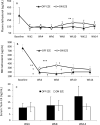Thyroid Hormone Status in Sitosterolemia Is Modified by Ezetimibe
- PMID: 28625503
- PMCID: PMC5572543
- DOI: 10.1016/j.jpeds.2017.05.049
Thyroid Hormone Status in Sitosterolemia Is Modified by Ezetimibe
Abstract
Objectives: To assess the association between biomarkers of thyroid status and 5α-stanols in patients with sitosterolemia treated with ezetimibe (EZE).
Study design: Eight patients with sitosterolemia (16-56 years of age) were studied during 14 weeks off EZE therapy and 14 weeks on EZE (10 mg/day). Serum thyroid biomarkers (free triiodothyronine [FT3], free thyroxine [FT4], FT3/FT4 ratio, thyroid-stimulating hormone), 5α-stanols (sitostanol and cholestanol), and cholestanol precursors (total cholesterol and its synthesis marker lathosterol, and 7α-hydroxy-4-cholesten-3-one cholestenol) were measured at baseline and during the 14 weeks off EZE and on EZE.
Results: EZE increased FT3/FT4 (10% ± 4%; P = .02). EZE reduced plasma and red blood cells sitostanol (-38% ± 6% and -20% ± 4%; all P < .05) and cholestanol (-18% ± 6% and -13% ± 3%; all P < .05). The change in plasma cholestanol level on EZE inversely correlated with the change in FT3/FT4 (r = -0.86; P = .01). EZE lowered total cholesterol (P < .0001) and did not affect 7α-hydroxy-4-cholesten-3-one cholestanol. EZE increased (P < .0001) lathosterol initially, but the level was not sustained, resulting in similar levels at week 14 off EZE and on EZE.
Conclusion: In patients with STSL, 5α-stanols levels might be associated with thyroid function. EZE reduces circulating 5α-stanols while increasing FT3/FT4, implying increased conversion of T4 to T3, thus possibly improving thyroid hormone status.
Trial registration: ClinicalTrials.govNCT01584206.
Keywords: 7α-hydroxy-4-cholesten-3-one; cholestanol; lathosterol; phytosterolemia; sitostanol; total cholesterol.
Copyright © 2017 Elsevier Inc. All rights reserved.
Conflict of interest statement
The authors declare no conflicts of interest.
Figures



Similar articles
-
Ezetimibe reduces plant sterol accumulation and favorably increases platelet count in sitosterolemia.J Pediatr. 2015 Jan;166(1):125-31. doi: 10.1016/j.jpeds.2014.08.069. Epub 2014 Oct 16. J Pediatr. 2015. PMID: 25444527 Free PMC article. Clinical Trial.
-
Effect of ezetimibe on low- and high-density lipoprotein subclasses in sitosterolemia.Atherosclerosis. 2017 May;260:27-33. doi: 10.1016/j.atherosclerosis.2017.03.015. Epub 2017 Mar 10. Atherosclerosis. 2017. PMID: 28340366 Free PMC article.
-
The natural history of phytosterolemia: Observations on its homeostasis.Atherosclerosis. 2018 Feb;269:122-128. doi: 10.1016/j.atherosclerosis.2017.12.024. Epub 2017 Dec 28. Atherosclerosis. 2018. PMID: 29353227
-
Two novel variants of the ABCG5 gene cause xanthelasmas and macrothrombocytopenia: a brief review of hematologic abnormalities of sitosterolemia.J Thromb Haemost. 2017 Sep;15(9):1859-1866. doi: 10.1111/jth.13777. Epub 2017 Aug 5. J Thromb Haemost. 2017. PMID: 28696550 Review.
-
Plant Sterols, Stanols, and Sitosterolemia.J AOAC Int. 2015 May-Jun;98(3):716-723. doi: 10.5740/jaoacint.SGEAjagbe. Epub 2015 May 4. J AOAC Int. 2015. PMID: 25941971 Free PMC article. Review.
Cited by
-
A Renewed Focus on the Association Between Thyroid Hormones and Lipid Metabolism.Front Endocrinol (Lausanne). 2018 Sep 3;9:511. doi: 10.3389/fendo.2018.00511. eCollection 2018. Front Endocrinol (Lausanne). 2018. PMID: 30233497 Free PMC article. Review.
-
Clinical features and genetic analysis of childhood sitosterolemia: Two case reports and literature review.Medicine (Baltimore). 2019 Apr;98(15):e15013. doi: 10.1097/MD.0000000000015013. Medicine (Baltimore). 2019. PMID: 30985648 Free PMC article. Review.
-
Dig deeper when it does not make sense: Juvenile xanthomas due to sitosterolemia.JIMD Rep. 2020 Aug 20;56(1):34-39. doi: 10.1002/jmd2.12161. eCollection 2020 Nov. JIMD Rep. 2020. PMID: 33204594 Free PMC article.
References
-
- Othman RA, Myrie SB, Jones PJ. Non-cholesterol sterols and cholesterol metabolism in sitosterolemia. Atherosclerosis. 2013;231:291–9. - PubMed
-
- Wang C, Lin HJ, Chan TK, Salen G, Chan WC, Tse TF. A unique patient with coexisting cerebrotendinous xanthomatosis and beta-sitosterolemia. The American journal of medicine. 1981;71:313–9. - PubMed
-
- Mushtaq T, Wales JK, Wright NP. Adrenal insufficiency in phytosterolaemia. European journal of endocrinology / European Federation of Endocrine Societies. 2007;157(Suppl 1):S61–5. - PubMed
-
- Idouji K, Kuriyama M, Fujiyama J, Osame M, Hoshita T. [Hypothyroidism with increased serum levels of cholestanol and bile alcohol--analogous symptoms to cerebrotendinous xanthomatosis] Rinsho shinkeigaku = Clinical neurology. 1991;31:402–6. - PubMed
-
- Bouwes Bavinck JN, Vermeer BJ, Gevers Leuven JA, Koopman BJ, Wolthers BG. Capillary gas chromatography of urine samples in diagnosing cerebrotendinous xanthomatosis. Archives of dermatology. 1986;122:1269–72. - PubMed
Publication types
MeSH terms
Substances
Supplementary concepts
Associated data
Grants and funding
LinkOut - more resources
Full Text Sources
Other Literature Sources
Medical

